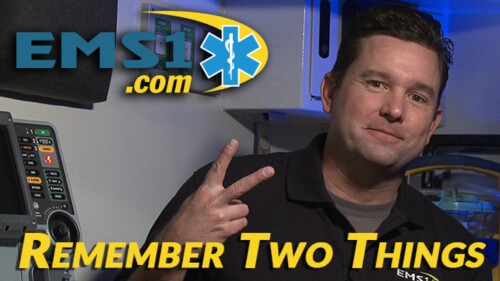The patient is insistent and the tone of the conversation is escalating. You can feel the energy in the room rising as the patient begins their rant again from the beginning, louder than before.
We’ve all been there. A simple call to 911 has escalated into an angry disagreement. Perhaps the patient insists on an inappropriate hospital for their destination. Or maybe they aren’t convinced that they need to go anywhere. They may be upset that a family member called, or that you didn’t remove your shoes prior to entering their home.
Regardless of the circumstances, most of us are well versed in recognizing that moment when the scene has transitioned from conversation to argument. What we often lack is the ability to respond appropriately.
Verbal de-escalation in the ambulance
I’d like to teach you an almost magical phrase that you can use to de-escalate many of the conflicts that we encounter in the course of prehospital care. That phrase is, “Let me see if I understand you correctly.”
I first encountered this phrase reading George Thompson’s book, Verbal Judo. At first glance, I was not terribly impressed. How could such an innocuous question stop a growing conflict in its tracks? It didn’t seem possible. Then I tried it. That’s when I became impressed.
Initially I didn’t understand why “Let me see if I understand you correctly” worked so well. I only knew that it was effective. I’d walk onto a scene with a patient and listen to the interaction for a few minutes. Often, the first thing out of my mouth was, “So, Dan … let me see if I understand you correctly” and for a few uninterrupted moments, the floor was mine.
As time went on, I began to analyze the phrase and its amazing ability to get people who were in the middle of an angry rant to stop, listen and reframe their argument.
There are 4 reasons why this magical de-escalation phrase works in EMS:
1. Angry people want to be heard
More often than not, when people are angry, they are angry because they feel that they aren’t being heard or that they aren’t being understood. This is why people invariably raise their voices at this moment. Subconsciously, they believe that they need to do something to improve our understanding of their feelings, their desires or their situation.
Once you say “Let me see if I understand you correctly,” you’re letting the patient know that hearing their position is important to you. You’re also requesting their assistance in helping you to understand. The sleight of hand is that your request also requires them to stop and listen for a few moments. It totally reframes their mindset.
If you want to see even the most angry person stop for a moment and listen, tell them that you are going to repeat their words back to them.
2. You are practicing active listening
Before you can honestly say “Let me see if I understand you correctly,” you need to actually listen and attempt to understand the patient’s position. Empathy is a powerful communication tool.
Consider their concerns, and how the situation looks through their eyes. Don’t throw this phrase around until you feel like you have an honest understanding of the patient’s point of view. If you follow the request up with an inaccurate understanding of their position, you will only validate their anger. Understand first, then request their attention.
3. Active listening disarms anger
If the patient’s anger and frustration was rooted firmly in the belief that they weren’t being listened to or understood, they now have to fall back and find some new fuel for their anger.
This buys precious time.
Taking the possibility of misunderstanding off the table is like taking a gun out of an assailant’s hand. You’ve taken away their primary weapon: the belief that they are being misunderstood. Once you’ve forced everyone in the conversation to come to a moment of mutual, confirmed understanding on the patient’s behalf, they need to proceed logically from that point.
That isn’t a guarantee that the conversation won’t devolve into misunderstanding and disagreement again, but it will create an opportunity for peaceful negotiation and resolution.
4. It creates an opportunity for a two-way conversation
Once the patient knows that you understand what they want to happen, you also have an opportunity to make on observation about that desire. If they know you are speaking directly to their desires, they are far more likely to listen to you. Try to fill this moment with an expression of empathy.
This will open the door for you to also be understood. It sounds something like this: “I can understand why you would want that to happen and I also think (insert your belief, feeling or need here).” This gives you a chance to switch a conversation from one of combative verbal jabs to one of mutually shared ideas.
As you learn to recognize the point where a conversation has transitioned to an argument, stop, listen, and take the time to understand why they are so frustrated. Try to reach a point where you honestly understand why they are feeling the way they are feeling.
Then say, “Let me see if I understand you correctly.”
What other comments or phrases do you find useful for bringing calm to conflict?
This article was originally posted May 1, 2014. It has been updated.



